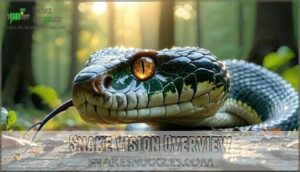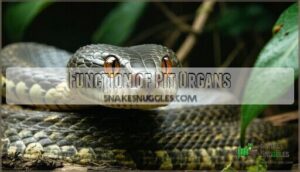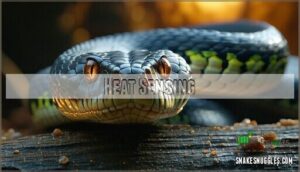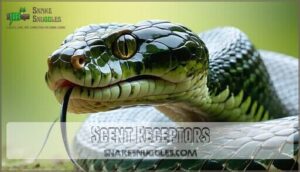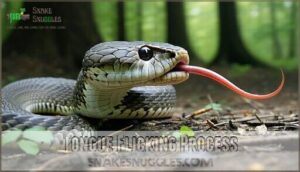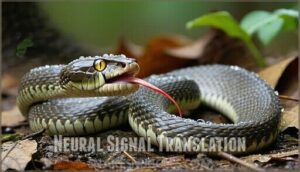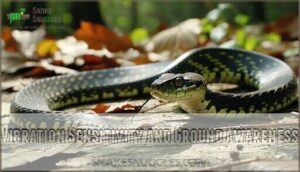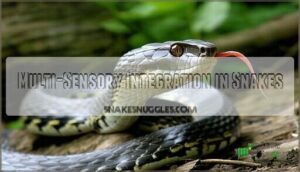This site is supported by our readers. We may earn a commission, at no cost to you, if you purchase through links.
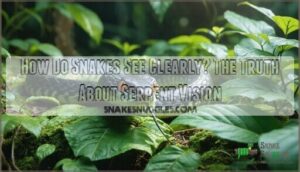
They can’t focus sharply on distant objects and see the world as somewhat blurry. However, they’ve evolved remarkable adaptations that make crystal-clear vision unnecessary.
Their eyes detect movement exceptionally well, and many species possess infrared-sensing pit organs that create thermal images of warm-blooded prey.
Combined with their incredible sense of smell through tongue-flicking and vibration detection through their bodies, snakes navigate their world through a sophisticated multi-sensory system that’s far more effective than relying on sharp eyesight alone.
These adaptations reveal nature’s ingenious solutions.
Table Of Contents
- Key Takeaways
- How Do Snakes See Clearly?
- Snake Vision Overview
- Infrared Vision and Pit Organs
- Scent Detection and Tongue Flicking
- Vibration Sensitivity and Ground Awareness
- Multi-Sensory Integration in Snakes
- Frequently Asked Questions (FAQs)
- What does a snake’s vision look like?
- Does a snake see clearly?
- How do snakes view humans?
- Do snakes see with their eyes or tongue?
- What does a snakes vision look like?
- What colors can snakes not see?
- Can snakes see in complete darkness?
- How do snakes see in the dark?
- Why do snakes flick their tongues?
- Can snakes see colour?
- Conclusion
Key Takeaways
- You don’t get clear vision from snakes because they’re essentially nearsighted with fixed-focus lenses that can’t adjust like yours can
- You’ll find they compensate through infrared detection using specialized pit organs that sense heat signatures from warm-blooded prey up to one meter away
- You’re watching them constantly flick their tongues to collect chemical information that gets processed through their Jacobson’s organ for detailed environmental mapping
- You can understand their hunting success comes from combining limited eyesight with vibration sensing through their bodies pressed against the ground
How Do Snakes See Clearly?
Snakes don’t see clearly in the traditional sense—their visual acuity falls short compared to humans.
However, their unique eye structure featuring spectacle scales and specialized focal length mechanisms creates an effective snake vision system.
The serpent visual system compensates for limited color perception through enhanced movement detection, making their clear vision mechanism perfectly suited for survival needs.
This reptile eyesight design prioritizes function over sharp detail, utilizing a system that is well-adapted to its environment, with enhanced movement detection.
Snake Vision Overview
You might be surprised to learn that snakes don’t actually see clearly in the traditional sense – their vision is considerably limited compared to yours.
Most snakes see the world through a blur, relying on heat and scent instead of sharp vision.
Instead of relying on sharp eyesight, snakes have evolved specialized adaptations that compensate for their visual shortcomings through unique filtering systems and hunting-specific modifications.
Limited Eyesight
You’re probably wondering why your pet snake seems to miss obvious prey right in front of them.
Visual acuity in snakes is dramatically lower than humans, with most species achieving only 20/100 vision compared to our 20/20 standard.
Their eye structure lacks focusing muscles, creating fixed focal length limitations beyond 30 centimeters.
This poor eyesight restricts color perception to just two primary colors, severely limiting optical clarity for detailed observation.
UV Filters
When daylight breaks, you’ll discover snake UV protection works like nature’s sunglasses. Day-hunting species possess specialized UV filters in their lens structure, while nocturnal hunters lack this protection for enhanced night vision.
Here’s how UV filters affect snake visual clarity:
- Diurnal snakes – UV filters in spectacle scales provide color vision enhancement and UV light sensitivity reduction
- Nocturnal species – No UV protection allows maximum light absorption through their reptilian visual system
- Visual clarity – Filtered light improves contrast detection and reduces glare during hunting
The use of UV protection glasses helps humans understand the importance of similar filters in snake vision.
Adaptation for Hunting
While hunting appears challenging with limited vision, you’ve got hunting strategies that maximize effectiveness through thermal imaging and infrared detection.
Your prey detection system combines visual cues with scent detection and vibration sensitivity for nocturnal hunting success.
| Hunting Method | Primary Sense | Effectiveness |
|---|---|---|
| Thermal Sensing | Infrared detection | Complete darkness |
| Movement Tracking | Visual cues | Daylight hunting |
| Chemical Trails | Scent detection | All conditions |
| Ground Vibrations | Vibration sensitivity | Close-range detection |
Infrared Vision and Pit Organs
You’ll discover that certain snake species possess specialized pit organs that function like thermal cameras, detecting infrared radiation from warm-blooded prey.
These remarkable sensors, located between the nostrils and eyes in vipers and pythons, can identify heat signatures from up to one meter away even in complete darkness.
Function of Pit Organs
Beyond their limited optical vision, certain snake species possess remarkable pit organ structure that functions like biological thermal cameras.
These specialized sensors enable infrared detection with extraordinary precision:
- Thermal imaging capabilities detect temperature differences as small as 0.003°C
- Heat sensing membranes convert infrared radiation into neural signals instantly
- Prey tracking accuracy increases dramatically through directional thermal mapping
You’ll find these organs positioned between the eyes and nostrils in pit vipers, pythons, and boas, creating an effective thermal sensing system for nocturnal hunting success.
Heat Sensing
You’ll discover that thermal imaging transforms how snakes hunt in darkness.
These pit organs detect infrared radiation from warm-blooded prey up to one meter away, creating detailed thermal maps of their environment.
This heat sensing capability is remarkably precise—snake infrared detection systems are ten times more sensitive than artificial sensors.
Thermal sensing allows pythons and vipers to track prey through infrared perception, giving them a hunting advantage that rivals night-vision technology in effectiveness and accuracy.
Neural Processing
Heat signals don’t just stop at detection—your brain’s neural processing transforms them into something remarkable.
Scientists believe snakes create detailed brain signals through specialized neural pathways that merge infrared data with regular sight.
This sensory integration produces visual coding that maps heat signatures like thermal blueprints.
The snake vision process combines visual perception with infrared detection through multisensory integration, enhancing cognitive functions.
While researchers haven’t cracked the complete code yet, this neural processing system clearly gives snakes their legendary hunting edge in total darkness.
This involves the TRPA1 protein activation for heat detection.
Scent Detection and Tongue Flicking
You’ve probably watched a snake flick its tongue and wondered what’s happening behind that mysterious behavior.
That forked tongue isn’t just for show—it’s actually collecting chemical information from the air to help the snake "see" its world through scent.
Scent Receptors
Your snake’s olfactory system works like a chemical detective, processing scent molecules through specialized nasal cavities and the remarkable vomeronasal organ.
Located in your serpent’s mouth roof, Jacobson’s organ detects chemical cues at incredibly low concentrations—down to parts per billion. This sophisticated smell detection system processes scent markers within milliseconds, giving snakes their legendary tracking abilities.
The vomeronasal organ’s scent perception capabilities far exceed what you’d expect:
- Ultra-sensitive detection: Processes chemical signals 1,000 times more effectively than basic nasal cavities
- Rapid neural processing: Translates scent molecules into actionable information within milliseconds
- Multi-chemical analysis: Simultaneously identifies prey, predators, and potential mates through distinct scent markers
This chemical cue processing system compensates brilliantly for limited eyesight, transforming your snake into a scent-guided hunter extraordinaire.
The snake’s ability to use forked tongue mechanisms enhances its overall sensing capabilities.
Tongue Flicking Process
You’ve probably wondered how that forked tongue works its magic.
Tongue Movement creates a sophisticated Air Sampling system through rapid tongue flicking. Each flick captures Chemical Signals from surrounding air, collecting scent molecules on specialized tongue tips.
This Scent Capture process enables precise Particle Detection, allowing snakes to map their environment through snake sensory perception.
The collected molecules transfer to scent receptors, creating detailed chemical maps for navigation and prey tracking.
Understanding the snake tongue anatomy is key to comprehending the complex processes involved in serpent vision and scent detection.
Neural Signal Translation
Chemical messengers transform your understanding of how snakes navigate their world through sophisticated neural signal translation.
When a snake’s forked tongue delivers scent molecules to the Jacobson’s organ, specialized receptor cells convert these chemical signatures into electrical impulses. These signals travel through dedicated neural pathways to the brain’s processing centers, where they’re decoded into meaningful information about prey location, predator presence, and environmental conditions.
The brain’s remarkable ability to interpret these chemical signals demonstrates nature’s engineering prowess. Unlike our visual-dominant perception, snakes rely heavily on this chemical communication system for survival decisions. Neural coding transforms molecular data into actionable intelligence within milliseconds.
Consider these fascinating aspects of snake neural processing:
- Synaptic transmission occurs at lightning speed, allowing immediate threat assessment and hunting responses
- Visual pathways integrate with chemical signals, creating a thorough sensory map of the environment
- Infrared perception combines with scent data through specialized neural connections, enabling precise prey targeting in complete darkness
This multi-layered signal processing gives snakes their legendary hunting accuracy.
Vibration Sensitivity and Ground Awareness
You might think snakes can’t detect much from their bellies pressed against the ground, but this position actually gives them a superpower for sensing vibrations.
When prey scurries nearby or predators approach, snakes feel these movements through their jawbones and body, creating a detailed map of their surroundings without needing to see a thing, which is based on sensing vibrations.
Proximity to Ground
Staying close to the ground gives you a tactical advantage when you’re a snake.
This Ground Vision perspective maximizes vibration sensitivity through direct contact with terrain surfaces.
Your Snake Posture creates ideal Terrain Adaptation for detecting subtle tremors that travel through soil and rock.
From this Low Angle position, Floor Detection becomes incredibly precise, allowing ground awareness to complement scent detection systems perfectly.
Prey Movement Detection
When you’re positioned close to the ground, every tiny movement becomes amplified through vibrations.
Snakes excel at this prey tracking technique, using their entire body as a sophisticated detection system. Their visual acuity might be limited, but their motion detection capabilities are extraordinary.
- Ground vibrations travel through their bodies, alerting them to nearby prey movement
- Hunting strategies rely heavily on detecting footsteps, scurrying, and other movement patterns
- Snake vision works alongside vibration sensing to create a complete picture of their surroundings
This movement detection system allows snakes to track prey even when visual perception fails them in darkness or dense vegetation.
Their snake camouflage keeps them hidden while they wait for those telltale vibrations that signal dinner is approaching. Unlike infrared detection, this method works for all prey types, making it an incredibly versatile hunting tool.
Surrounding Awareness
Beyond movement detection, snakes use vibration sensitivity for spatial awareness of their entire environment.
Your snake’s body acts like a living seismograph, detecting environmental cues through ground tremors that reveal approaching predators or territorial threats.
This awareness mechanism works through sensory integration, where vibration data combines with peripheral vision and infrared detection to create a detailed picture.
Think of it as nature’s early warning system – while you might need security cameras, snakes rely on their belly’s contact with earth to monitor their surroundings.
This thermal radiation detection and scent detection network helps them stay vigilant in their territory.
The ability to detect chemical cues through forked tongue mechanisms also plays a vital role in their overall sensory perception.
Multi-Sensory Integration in Snakes
You’ll discover that snakes don’t rely on crystal-clear vision like you might expect—instead, they’ve mastered the art of combining multiple senses into one powerful detection system.
This multi-sensory approach gives them a survival advantage that’s far more effective than perfect eyesight alone, providing a unique survival advantage.
Evolutionary Adaptations
Throughout evolution, snakes developed remarkable sensory evolution strategies that compensate for their limited snake vision.
You’ll find that genetic changes in visual pigment genes created fascinating visual tradeoffs – while they lost sharp eyesight, they gained extraordinary abilities like infrared detection through specialized pit organs.
These adaptive traits allowed species diversification across different environments, from desert hunters to forest ambush predators.
Evolutionary adaptations transformed their spectacle scales and enhanced their ability to process thermal information alongside traditional vision.
Rather than viewing poor visual acuity as a limitation, snakes evolved a multi-sensory approach that’s actually more effective than relying solely on sight, giving them a distinct survival advantage in their ecological niches.
This is a prime example of convergent evolution in action, where unrelated species develop similar traits in response to similar environmental pressures.
Predator and Prey Relationships
Snake vision works as part of a sophisticated survival system where predator-prey relationships shape every sensory adaptation.
You’ll find their hunting strategies rely heavily on infrared detection and vibration sensitivity to track warm-blooded prey, while their predator avoidance tactics use the same heat sensing abilities to detect approaching threats.
This adaptive behavior creates a perfect balance in nature’s chess game.
Survival Advantage
Looking at predator-prey relationships reveals how these evolutionary benefits truly manifest in the wild.
You’ll find that snake vision limitations become strengths through sophisticated sensory tradeoffs that enhance survival rates.
Their multi-sensory approach creates unmatched hunting strategies through:
- Infrared detection for tracking warm-blooded prey in darkness
- Vibration sensitivity for detecting ground movement patterns
- Heat sensing combined with environmental adaptation for precise strikes
This integration transforms potential weaknesses into evolutionary advantages. Rather than relying solely on visual input, snakes developed extensive sensory networks that excel at predator avoidance while maximizing hunting efficiency across diverse habitats.
The use of thermal imaging devices, such as those found in infrared camera systems, can help researchers better understand these complex sensory interactions.
Frequently Asked Questions (FAQs)
What does a snake’s vision look like?
While you might think snakes have poor eyesight, they actually see a unique world through dichromatic vision that detects two primary colors plus ultraviolet light.
Movement-focused clarity, and infrared heat signatures.
Does a snake see clearly?
You’ll find that snakes don’t see clearly in the traditional sense—their vision is quite blurry compared to yours.
They’re basically nearsighted, with fixed lenses that can’t adjust focus like your eyes do.
How do snakes view humans?
You’ll appear as a heat signature and moving target to snakes, not as a detailed visual form.
They detect your warmth through specialized sensors rather than seeing you clearly like humans do.
Do snakes see with their eyes or tongue?
Snakes use both their eyes and tongues for different purposes.
They rely on their eyes for detecting movement and basic vision, while their tongues collect chemical information from the environment for detailed spatial awareness.
What does a snakes vision look like?
Like viewing the world through frosted glass, you’ll see a blurred landscape where movement and heat signatures matter more than sharp details.
Your dichromatic vision captures blues and greens while infrared sensors detect warm prey in darkness, creating a unique thermal-visual hunting advantage.
What colors can snakes not see?
Most snakes can’t see red wavelengths, relying on dichromatic vision with just blue and green sensitivity.
You’re missing that rich red spectrum humans enjoy, though some species detect ultraviolet light for environmental navigation.
Can snakes see in complete darkness?
Imagine darkness as a thick curtain where most creatures stumble blindly, yet certain serpents navigate like thermal detectives.
While snakes can’t see visually in complete darkness, pit vipers, pythons, and boas detect infrared radiation from warm-blooded prey using specialized heat-sensing organs.
How do snakes see in the dark?
You’ll see nocturnal snakes navigate darkness using specialized pit organs that detect infrared radiation from warm-blooded prey.
These heat-sensing organs work alongside enhanced rod cells in their retinas for superior low-light vision, utilizing infrared radiation to detect warm-blooded prey.
Why do snakes flick their tongues?
Nature’s chemical detectives use their forked tongues like tiny sampling tools to collect scent molecules from the air.
You’ll see them flick tongues constantly because they’re gathering chemical information about prey, predators, and mates through specialized receptors, using their tongues to gather data about their environment and potential mates.
Can snakes see colour?
You’ll discover that snakes have dichromatic color vision, meaning they see only two primary colors compared to your three.
Most species perceive blue and green wavelengths, with some also detecting ultraviolet light for enhanced environmental awareness.
Conclusion
Consider a python hunting at dusk – while you’re relying on your sharp vision to spot movement, the snake detects your warm body heat through specialized pit organs before you even notice it’s there.
Understanding how do snakes see clearly reveals they don’t depend on traditional vision at all.
Instead, they’ve mastered a sophisticated sensory network combining limited eyesight with infrared detection, chemical analysis through tongue-flicking, and vibration sensing.
This multi-sensory approach proves more effective than clear vision alone, demonstrating evolution’s practical solutions to survival challenges.
- https://www.nhm.ac.uk/discover/news/2016/september/study-sheds-light-on-snake-vision.html
- https://www.biosphereonline.com/2016/09/06/snake-vision-what-do-snakes-see/
- https://www.optica-opn.org/home/newsroom/2020/october/illuminating_the_infrared_vision_of_snakes/
- https://today.uconn.edu/2021/06/smelling-in-stereo-the-real-reason-snakes-have-flicking-forked-tongues/
- https://howitsee.com/what-colors-do-snakes-see/

